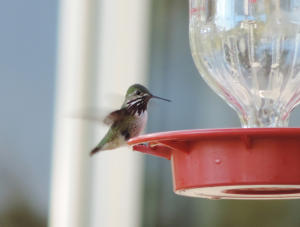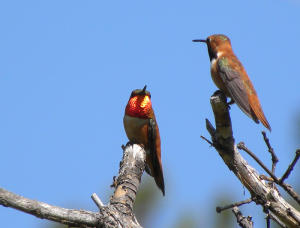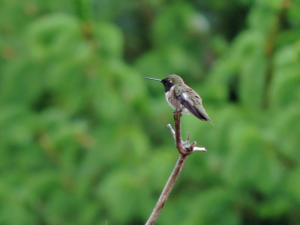Which birds might I see today? Hummingbirds
Perhaps the reason I love hummingbirds so much is that I grew up in England where there aren’t any. I never tire of watching them seek out nectar from our feeders or the flowers and shrubs in the garden.
Four species of hummingbird can be seen here though not Ruby-throated Hummingbirds, only found east of the Rockies. Anna’s Hummingbirds, which are year round at the coast, occasionally turn up here in winter. But it is the trio of Calliope, Rufous and Black-chinned Hummingbirds that enchant us in the summer when they come here to breed.

The Calliope Hummingbird is North American’s smallest bird, at only 3 1/4 “ from tip of beak to tip of short tail. Yet this tiny bird migrates to Central or South America to spend our winters, an incredible journey for such a small creature.
Calliope Hummingbird males have a unique ray of feathers at the throat, glowing iridescently when they catch the light in a sudden flash of rosy magenta. Unlit, these feathers look black. The female has a green back and plain buffy underparts.

Just ½” larger the Rufous Hummingbird is easy to identify with his rusty-orange back and brilliant orange throat feathers. Like those of the Calliope, these throat feathers look black when not in direct light. The Rufous Hummingbird female has a tiny triangle of iridescence at her throat and some hints of rust colour here and there in her feathers.

Much rarer than either of these two is the Black-chinned Hummingbird, though I usually see one or two each summer. While its throat feathers look black too, hence its name, they are a brilliant rich purple when lit, bordered below with a broad white band, very dramatic. These are slender birds, and their beaks are slightly down-curved.
In our latitudes a hummingbird syrup in proportions 3:1 is recommended. Dissolve one cup of sugar in 3 cups of water, heat until boiling and boil for one minute, then cool before filling your feeder. Food colouring has been shown to damage the birds’ internal organs, so is best avoided. Change the syrup at least once a week, washing the feeder out in hot water between fillings. Keep unused syrup in a clean jar in the fridge.
Male hummingbirds will leave as early as July to begin the long migration southwards. They often migrate at higher elevations along the mountain meadows where late-blooming flowers provide the nectar on which they feed. The ‘wife and kids’ will probably all be gone by the third week in August. Make the most of them while they are still here!
Pam Laing, Lake Country birder







0 Comments